
A militia is generally an army or some other fighting organization of non-professional soldiers, citizens of a country, or subjects of a state, who may perform military service during a time of need, as opposed to a professional force of regular, full-time military personnel; or, historically, to members of a warrior-nobility class. Generally unable to hold ground against regular forces, militias commonly support regular troops by skirmishing, holding fortifications, or conducting irregular warfare, instead of undertaking offensive campaigns by themselves. Local civilian laws often limit militias to serve only in their home region, and to serve only for a limited time; this further reduces their use in long military campaigns.
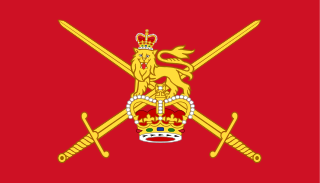
The Army Reserve is the active-duty volunteer reserve force of the British Army. It is separate from the Regular Reserve whose members are ex-Regular personnel who retain a statutory liability for service. The Army Reserve was known as the Territorial Force from 1908 to 1921, the Territorial Army (TA) from 1921 to 1967, the Territorial and Army Volunteer Reserve (TAVR) from 1967 to 1979, and again the Territorial Army (TA) from 1979 to 2014.
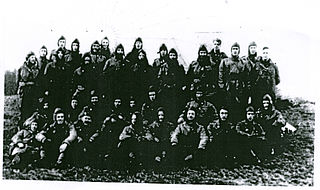
Operation Colossus was the codename given to the first airborne operation undertaken by the British military, which occurred on 10 February 1941 during World War II. The British airborne establishment was formed in June 1940 by the order of the British Prime Minister, Winston Churchill, in response to the successful airborne operations conducted by the German military during the Battle of France. Training began immediately but a shortage of proper equipment and training facilities, as well as bureaucratic difficulties, meant that only a small number of volunteers could immediately be trained as parachute troops. The first airborne unit to be formed was actually a re-trained Commando unit, No. 2 Commando, which was subsequently renamed as No. 11 Special Air Service Battalion and numbered approximately 350 officers and other ranks by September 1940. The battalion finished its training in December 1940 and in February 1941 thirty-eight members of the battalion, known as X Troop, were selected to conduct an airborne operation, which was intended to test the capability of the airborne troops and their equipment, as well as the ability of the Royal Air Force to accurately deliver them.
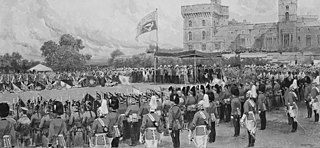
The Territorial Force was a part-time volunteer component of the British Army, created in 1908 to augment British land forces without resorting to conscription. The new organisation consolidated the 19th-century Volunteer Force and yeomanry into a unified auxiliary, commanded by the War Office and administered by local County Territorial Associations. The Territorial Force was designed to reinforce the regular army in expeditionary operations abroad, but because of political opposition it was assigned to home defence. Members were liable for service anywhere in the UK and could not be compelled to serve overseas. In the first two months of the First World War, territorials volunteered for foreign service in significant numbers, allowing territorial units to be deployed abroad. They saw their first action on the Western Front during the initial German offensive of 1914, and the force filled the gap between the near destruction of the regular army that year and the arrival of the New Army in 1915. Territorial units were deployed to Gallipoli in 1915 and, following the failure of that campaign, provided the bulk of the British contribution to allied forces in the Sinai and Palestine Campaign. By the war's end, the Territorial Force had fielded twenty-three infantry divisions and two mounted divisions on foreign soil. It was demobilised after the war and reconstituted in 1921 as the Territorial Army.
The Officers' Training Corps (OTC), more fully called the University Officers' Training Corps (UOTC), are military leadership training units operated by the British Army. Their focus is to develop the leadership abilities of their members whilst giving them an opportunity to take part in military life whilst at university. OTCs also organise non-military outdoor pursuits such as hill walking and mountaineering. UOTC units are not deployable units nor are their cadets classed as trained soldiers. The majority of members of the UOTC do not go on to serve in the regular or reserve forces.

Auxiliaries are support personnel that assist the military or police but are organised differently from regular forces. Auxiliary may be military volunteers undertaking support functions or performing certain duties such as garrison troops, usually on a part-time basis. Unlike a military reserve force, an auxiliary force does not necessarily have the same degree of training or ranking structure as regular soldiers, and it may or may not be integrated into a fighting force. Some auxiliaries, however, are militias composed of former active duty military personnel and actually have better training and combat experience than their regular counterparts.
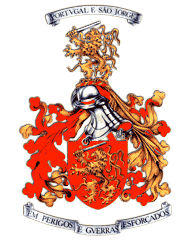
The Portuguese Army is the land component of the Armed Forces of Portugal and is also its largest branch. It is charged with the defence of Portugal, in co-operation with other branches of the Armed Forces. With its origins going back to the 12th century, it can be considered one of the oldest active armies in the world.

The Bermuda Volunteer Rifle Corps (BVRC) was created in 1894 as a reserve for the Regular Army infantry component of the Bermuda Garrison. Renamed the Bermuda Rifles in 1951, it was amalgamated into the Bermuda Regiment in 1965.
The Canadian Militia is a historical title for military units raised for the defence of Canada. The term has been used to describe sedentary militia units raised from local communities in Canada; as well as the regular army for the Province of Canada and post-confederated Canada, referred to as the active militias.

The Territorial and Reserve Forces Act 1907 was an Act of the Parliament of the United Kingdom that reformed the auxiliary forces of the British Army by transferring existing Volunteer and Yeomanry units into a new Territorial Force (TF); and disbanding the Militia to form a new Special Reserve of the Regular Army. This reorganisation formed a major part of the Haldane Reforms, named after the creator of the Act, Richard Haldane.
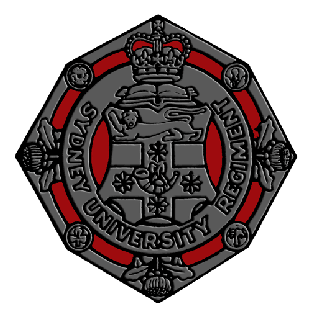
Sydney University Regiment (SUR) is an officer-training regiment of the Australian Army Reserve. Its predecessor, the University Volunteer Rifle Corps, was raised in 1900 as a unit of the colonial New South Wales Defence Force. During the 20th century, several changes of name and role occurred. Sydney University Regiment is headquartered in Holsworthy Barracks and has detachments in Sydney, Canberra and Wollongong.
The Volunteer Force was a citizen army of part-time rifle, artillery and engineer corps, created as a popular movement throughout the British Empire in 1859. Originally highly autonomous, the units of volunteers became increasingly integrated with the British Army after the Childers Reforms in 1881, before forming part of the Territorial Force in 1908. Most of the regiments of the present Territorial Army Infantry, Artillery, Engineers and Signals units are directly descended from Volunteer Force units.

The Italian National Republican Guard was a gendarmerie force of the Italian Social Republic created by decree on December 8, 1943, replacing the Carabinieri and the National Security Volunteer Militia (MVSN). General Renato Ricci appointed as its commandant. Major General Italo Romegialli was appointed vice commandant and Major General Niccolò Nicchiarelli became the chief of general staff.
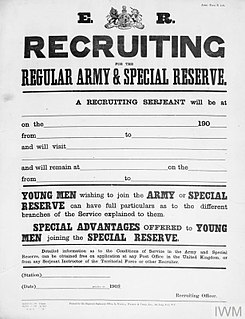
The Special Reserve was established on 1 April 1908 with the function of maintaining a reservoir of manpower for the British Army and training replacement drafts in times of war. Its formation was part of the military reforms implemented by Richard Haldane, the Secretary of State for War, which also created the Territorial Force. Haldane originally intended that the Militia would provide the reserve, but opposition from its representatives forced him to abolish it and create the Special Reserve instead. Only 60 per cent of the Militia transferred into the new reserve, and it was consistently under strength, particularly in officers. Reservists enlisted for a six-year term of service, and had to undergo six months of basic training on recruitment and three to four weeks training annually. The Special Reserve was organised into battalions, providing a third for each of the regular army's 64 two-battalion infantry regiments and a fifth and sixth for the five four-battalion infantry regiments. In addition to providing replacements to the regular army, the Special Reserve was deployed on home defence duties guarding the coast and key installations during the First World War. The routine nature of its duties meant that scant attention was paid to it in regimental histories. After the war, the Special Reserve was abolished and the Militia was resurrected in 1921 to take on its former role. No effort was made to restart recruitment, and in 1924 the new Militia's functions were absorbed into the Supplementary Reserve.
The Militia of the United Kingdom were the military reserve forces of the United Kingdom of Great Britain and Ireland after the Union in 1801 of the former Kingdom of Great Britain and Kingdom of Ireland. The militia was transformed into the Special Reserve by the Territorial and Reserve Forces Act 1907. For the period before the creation of the United Kingdom, in the home nations and their colonies, see Militia.
In some Southern European and Latin American countries University Militias were military units for training university students.

The Haldane Reforms were a series of far-ranging reforms of the British Army made from 1906 to 1912, and named after the Secretary of State for War, Richard Burdon Haldane. They were the first major reforms since the "Childers Reforms" of the early 1880s, and were made in the light of lessons newly learned in the Second Boer War.

The Bermuda Garrison was the military establishment maintained on the British Overseas Territory and Imperial fortress of Bermuda by the regular British Army and its local militia and voluntary reserves from 1701 to 1957. The garrison evolved from an independent company, to a company of Royal Garrison Battalion during the American War of Independence, and a steadily growing and diversifying force of artillery and infantry with various supporting corps from the French Revolution onwards. During the American War of Independence, the garrison in Bermuda fell under the military Commander-in-Chief of America. Subsequently, it was part of the Nova Scotia Command until 1868, and was an independent Bermuda Command from then 'til its closure in 1957.

The University of Santo Tomas Golden Corps of Cadets (UST-GCC) also referred to as the UST ROTC Unit is a Reserve Officers' Training Corps unit implementing one of the optional components of the Philippines' National Service Training Program (NSTP) in the University of Santo Tomas. The NSTP is a civic education and preparedness program for college students, the ROTC component of which aims to provide military education and training to mobilize them for national defense preparedness.

Elements of the Second Australian Imperial Force (AIF) were located in the United Kingdom (UK) throughout World War II. For most of the war, these comprised only a small number of liaison officers. However, between June and December 1940 around 8,000 Australian soldiers organised into two infantry brigades and supporting units were stationed in the country. Several small engineer units were also sent to the UK, and up to 600 forestry troops were active there between July 1940 and mid-1943. A prisoner of war (POW) repatriation unit arrived in the UK in August 1944, and over 5,600 released AIF prisoners eventually passed through the country. Following the war, small numbers of Australian soldiers formed part of a military cricket team which toured England, and the Army contributed most members of the Australian contingent to the June 1946 victory parade in London.














